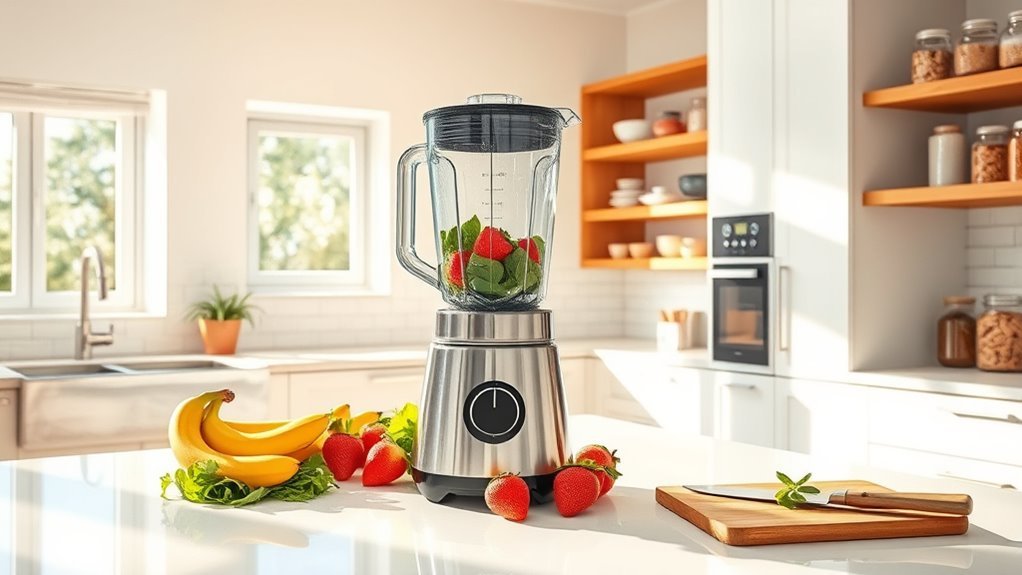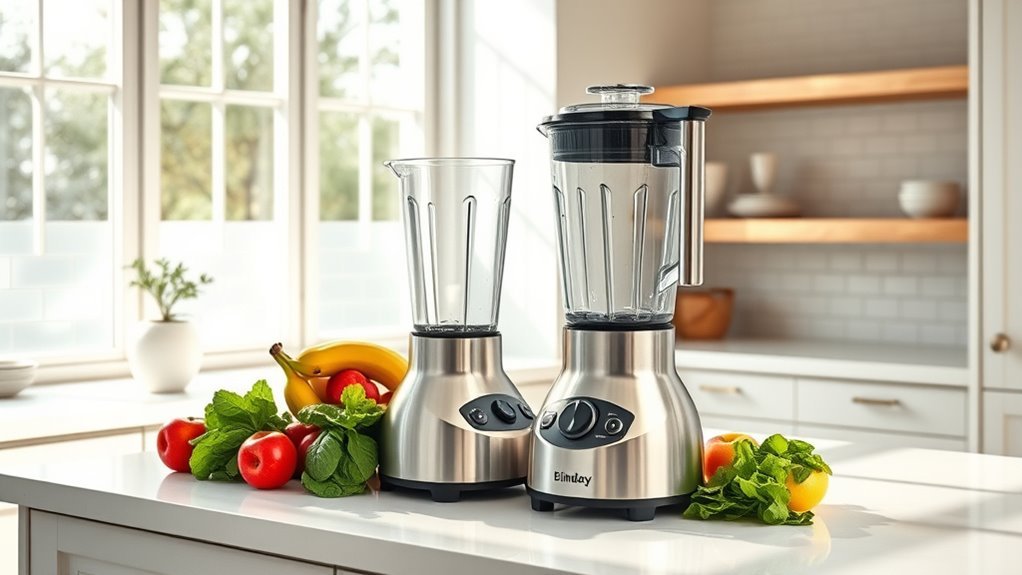We’ll help you triple your blender blade’s lifespan with these proven tips: Cut ingredients into 2-inch chunks, add liquid for dry items, respect capacity limits, and start slow before ramping up speed. Clean immediately with warm water (no harsh chemicals), dry thoroughly, and inspect monthly for wear. Don’t forget proper storage and regular maintenance. Smart blade care now means years of smooth blending ahead – there’s more to maximizing performance than meets the eye.
Proper Loading Techniques to Prevent Blade Stress

When it comes to preserving your blender’s blades, proper loading technique is your first line of defense.
We’ll show you how to load ingredients like a pro to keep those blades razor-sharp and efficient.
Start by cutting hard ingredients into 2-inch pieces – no exceptions. Your blender’s not a wood chipper, so don’t treat it like one.
Always add a small amount of liquid when blending dry ingredients; it’s non-negotiable for smooth operation and blade protection.
And please, respect your blender’s capacity limits. Overloading isn’t just inefficient – it’s blade suicide.
Remember our golden rule: start slow, then gradually increase speed.
It’s like warming up before a workout – your blender blades need that gentle introduction to perform their best. Additionally, using your blender frequently can lead to better performance and durability if you follow proper care techniques, including proper loading techniques.
Essential Pre-Blending Food Preparation
Before your ingredients ever touch those precious blades, they’ll need proper prep work – it’s non-negotiable.
When using the blender, cut everything into 2-inch chunks – your motor will thank you. Think uniform sizes: they’re vital for even blending and preventing blade damage.
Here’s the deal with your blender jar: always add liquid when processing dry ingredients. We’re not running a food processor here – your blender needs that moisture to prevent sticking and keep those blades sharp.
And please, no ice or raw potatoes – they’re blade killers.
Start with softer items first, then gradually add the rest while blending. This method isn’t just some fancy technique – it’s your insurance policy against premature blade wear and tear. Additionally, using a high-performance blender can enhance your blending experience and prolong the lifespan of the blades.
Smart Speed Settings for Different Ingredients

Proper food prep is only half the battle – mastering your blender’s speed settings is what’ll keep those blades singing. When we’re using a blender, smart speed settings make all the difference in protecting that blade assembly.
Here’s our battle plan: Start low and slow, always. For softer ingredients like bananas, we’ll kick it up to medium. Got frozen fruit or ice? Pulse at low speed first, then gradually increase. Think of it like warming up before a workout – your blender needs the same courtesy.
Don’t just wing it, though. Each blender’s got its quirks, so check your manual for specific speed recommendations.
We’re looking for that sweet spot where ingredients blend perfectly without overworking the motor. Monitor, adjust, perfect – that’s our mantra.
Daily Cleaning Practices for Blade Protection
Since diligent cleaning is the secret weapon for blade longevity, we’ve got to nail our post-blend maintenance routine.
Right after blending, hit those blades with warm, soapy water – no exceptions. Food residue is your enemy here, folks.
Let’s be smart about our cleaning tools. Grab a soft brush or cloth for stubborn bits, but ditch those abrasive scrubbers – they’ll wreck your blades faster than a smoothie gone wrong.
And please, no harsh chemicals. Once you’ve cleaned everything, thoroughly dry those blades before reassembly. Moisture leads to rust, and rust means death to your blending game.
Keep your eyes peeled for signs of wear. When blades start looking tired or performance drops, it’s time for sharpening or replacement. No compromises.
Monthly Blade Maintenance Schedule

While daily cleaning keeps your blades running, a monthly deep-dive maintenance session is non-negotiable.
Let’s be clear: your blender is designed to last, but only if you give it proper attention.
Start by inspecting those blades for wear, dullness, or bending – we’re talking CSI-level scrutiny here.
Next, we’ll get intimate with a soft brush or cloth to remove every stubborn food particle.
Don’t skip the lubrication of moving parts; it’s like giving your blade assembly a spa day that prevents costly motor damage.
Here’s the non-negotiable part: always let everything dry before reassembling.
We’re not messing around with moisture-related damage.
Sharpen or replace blades when needed – your smoothies will thank you, and so will your wallet.
Storing Your Blender to Preserve Blade Quality
How you store your blender is just as critical as how you use it.
Let’s take care of your investment by finding a safe place that’s cool and dry, away from moisture that can wreak havoc on those precious blades.
Keep the bottom of the blender clear of any heavy items that could damage the mechanism.
- Always unplug your blender when it’s not in action – those accidental starts aren’t doing your blades any favors
- Dry everything thoroughly before reassembly – moisture is your blade’s worst enemy
- Use a dust cover or cabinet storage to shield your blades from debris
Recognizing Signs of Blade Wear and Replacement
Even the best blade maintenance won’t last forever. We’ve got to stay vigilant for signs that our blender blades need replacement. Watch for these telltale indicators: ingredients taking longer to blend, uneven results, or food getting stuck despite proper liquid levels. These aren’t just annoyances – they’re your blender’s cry for help.
Listen for unusual sounds during operation – they’re often the first warning of loose or damaged blades.
Regular visual inspections are essential. Look for bent, chipped, or corroded blades that’ll compromise both performance and safety. Rust isn’t just unsightly; it’s a contamination risk that demands immediate replacement.
When your blending sessions start feeling more like endurance tests than food prep, it’s time for new blades.
Frequently Asked Questions
How Do I Make My Blender Last Longer?
Mindful maintenance matters! We’ll help your blender last by regularly cleaning blades, avoiding hard ingredients, securing lids properly, using smaller portions with liquids, and replacing gaskets when needed.
How Often Should I Replace My Blender Blade?
We recommend replacing blender blades every 6-12 months, monitoring blade wear indicators like struggling performance and uneven textures. Watch for signs of dullness, especially if you’re frequently blending hard ingredients.
Do Eggshells Actually Sharpen Blender Blades?
Despite what 65% of home cooks believe, eggshells don’t sharpen blender blades. We’ve found this common blade maintenance myth actually damages blades over time, dulling them faster than normal use would.
How Many Years Does a Blender Last?
We’ll typically get 5-10 years from our blenders with proper maintenance tips. Watch for common issues like motor strain and blade dulling. Signs of wear signal when it’s time for replacement.

